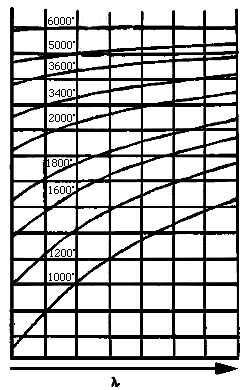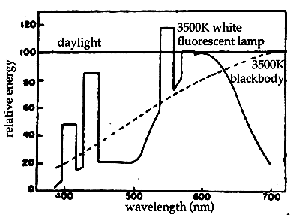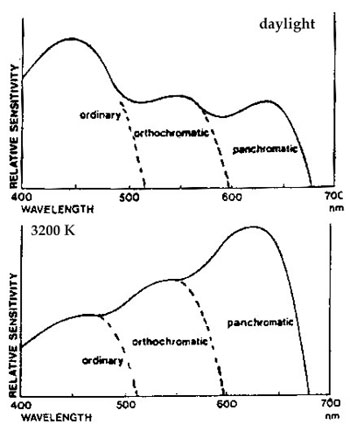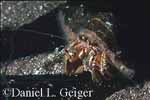INDEX
Basics
LIGHT INTENSITY
The amount of light is one of the most important factors in photography,
which determines many settings. In photography one is mostly interested
in changes in illumination of a factor of 2 (increase or decrease).
Such a two-fold change is termed a change of one f-stop;
therefore, the f-stop scale is exponential to the base 2. The term
f-stop is taken from the diaphragm settings on a lens, i.e. the
numbers like 2, 2.8, 4, 5.6, 8 etc.. The difference between two
stops is a factor of square root of 2 (because I / d2
= constant: see below). Generally all photographic products are
made to a precision of ± 10%: absolute accuracy with the settings
is not necessary, and the smallest change of intensity you may start
to take into account is 1/3 of an f-stop (= 1 DIN: see below). We
have to distinguish between two kinds of light intensity: incident
light and reflected light. All built-in camera light-meters
are adjusted to measure reflected light levels, assuming the object
to be neutral gray, which by definition reflects 18% of the incident
light; some hand held light meters can be used to measure incident
or reflected light. Kodak produces the Neutral Gray Cardboard
(NGC: 18% reflection) which is very helpful as a reference
with the use of critical objects. The reflective properties of either
black or white differ from neutral gray by approximately 2 f-stops
(for half tone-films: see below). Light intensity (I) changes with
distance (d) from the light source according to the following law:
I / d2 = constant. This relation is important when using
any artificial light sources (photo lamps, cold-light, flashes).
Note: In order to get a reliable reading
of the light meter, use the NGC in the place of the object to be
taken a picture of. Check the illumination of the object and adjust
the exposure time to the value from the NGC using the ± correction
or changing the film speed. If you cannot place the neutral gray
card in place of the object, or if the object is not in the same
focal plane as the majority of the picture (bird against sky), guess
neutral gray correction, and make an exposure series of ± 2/3 f-stop,
possibly additionally ± 4/3 f-stop.
Note: if this procedure does not work at
all, and particularly if the camera with no correction for non-neutral
gray objects gives you half-way reasonable results, your camera
may be utilizing a so-called matrix meter; you may want
to check with the camera manual. If this is the case, try to switch
the matrix metering system off, and to switch to some sort of integral
measurement and to do the above procedures. Matrix metering gives
you a reasonable shot of an average scene, but it is very hard to
predict the performance of the system in more demanding situations.
The more reliable method is using the neutral gray card.

THE COLOR OF LIGHT
In color photography the color balance is of major importance.
Both, the properties of the film and the light source have to be taken
into account. The color of the light source is called "temperature",
indicated in Kelvin, referring to the actual temperature the tungsten
wire when emitting light of a certain color balance. The yellowish
light of indoor light sources have low values (2,400- 2,800 K), regular
photofloods have 3,200 K, special photoflood lamps 3,400 K, whereas
daylight and electronic flashes are usually between 5,000-6,000 K.
Note that the color balance varies tremendously over the range of
color temperatures. This means that the cold temperatures have a rather
high proportion of the far (red) spectrum, whereas the 5000-6000 K
is more or less balanced between the blue and the red end of the spectrum.
The figure on the left charts the emission spectrum at various temperatures
from 400 to 750 nm wavelength. The films are adjusted to a certain
color-temperature of the light source. Differences between the light
source and the film are measured in Mired,
and can be balanced using color-conversion (e.g. 80A, 80B,
80C) and color-correction filters (Yellow, Magenta, Cyan).
All filters absorb some light and eventually the exposure time has
to be increased; the f-stop value to which the new shutter speed has
to be adjusted, is the factor of reciprocity indicated on the technical
data sheet. If multiple filters are used, the filter factors have
to be multiplied (recall law of extinction).
Note: the color temperature of a light bulb is dependent
on the voltage used with the light source; glasfiber optics lights
with halogen bulbs change color-temperature with intensity and their
3,200 K refer to the nominal voltage. You can measure the color temperature
of a light source with specialized, fairly expensive, dedicated color
temperature meters. Fortunately there is a cheaper, reasonable approximation.
As you note from the color temperature chart, the temperature can
be approached as a ratio between the proportions of red to blue light.
Hence, you can measure the light intensity of a give light source
with a strong blue and red filter of equal filter factor in place
and note the difference in the intensity reading. Be aware that the
spectral sensitivity of light meters differ, so it is a good idea
to calibrate your system against a known light source; I would suggest
a new 3200 K photoflood lamp.

Note: the emission-spectrum of a fluorescent
and high-energy discharge lamps are very irregular with square (!)
peaks as shown above. The figure compares the even spectrum of daylight
with that of a blackbody (stippled line) and the spectrum of a fluorescent
tube. Filtering has to be determined for every combination of film
and tube type separately; the effect is unpredictable. Some approximate
recommendations are available with the technical data sheet for
some films, e.g. Ektachrome films.
FILM SPEED
Film speed is a measure used for the correct exposure of the film.
All other conditions being equal, a low numerical value (slow
film) will require a longer exposure time, than one with a
high value (fast film). There are two different systems:
the ISO/ASA- and the DIN-scale. With ISO/ASA a two fold
change in film speed (= 1 f-stop = two fold change in exposure time)
is reflected in a two fold change in the numerical ISO/ASA-value.
On the DIN-scale a change of 1 f-stop is indicated by adding or
subtracting 3 DIN-units: ISO/ASA 100 = 21 DIN, ISO/ASA 50 = 18 DIN.
Often it is necessary to have a faster film speed
than the film indicates. With many films you can change the speed-settings
on the camera and develop the film specially with a so-called push-
an pull-treatment. Most films give good results with - 1 f-stop,
and acceptable results with - 2 f-stops. The odds are a larger grain,
enhanced contrast and stronger and unnatural colors. As high
speed color films I rather strongly recommend the Fuji MS 100/1000.
It has come on the market just in summer 1998. The grain is that
of a 200 to 400 speed film (RMS 10-16) and the colors are pretty
nice over the entire speed range. A SLIGHT increase in contrast
and color saturation can be noticed, but it is by far less than
with the previously available material. The film is nominally developed
at ISO 100 adn with a push 4 at ISO 1000 in standart E6 chemistry.
The Agfachrome 1000 RS has a very coarse grain but fairly natural
colors. The Ektachrome P800/1600 is rather a high contrast film
(HC) and the trend is accentuated with increasing speed; the colors
are painfully intense. A pull-treatment to a lower speed can also
be used, but rather use a film with a slower speed. If the light
level has to be reduced, neutral density filters (ND) can be used.
The strength is indicated in f-stop values (ND2, ND4, ND8). Ideally
they should be also neutral in color, however only the Agfa ND-filters
show a linear absorption spectrum. Kodak Chrome slide films can
only be exposed at the nominal speed.

FILMS
Black and White (B&W) films. There are two groups of films
which translate the contrast of the gray scale differently. Half-tone
films reproduce the gray scale as accurately to the originals possible.
Lithographic films have a much higher contrast, and basically
just show either black or white but no gray-tones; these films are
used for presentation slides when you use collages as originals:
different white-tones are leveled out and margins become invisible.
-- Note: the contrast is dependent on the film type and
the developer and the time and temperature of development (see figure
on next page). -- A second grouping indicates how the colors are
translated into gray-tones, which is illustrated on the right. Unsensitized
films only respond to blue tones, orthochromatic films
include also the green part of the spectrum, but are red-insensitive,
and panchromatic films cover the whole spectrum of the
visible light (see figure below). Therefore, you may process the
first two groups with red safety light, but the panchromatic films
have to be processed in complete darkness. Most B&W films are negative
films, however there is the Agfa Scala , which produces
half tone slides. For presentation slides you can also make an "internegative"
which you re-photograph or contact-copy with a negative film, which
results in a positive (slide). The Ilford XP-1 / XP-2 is
a very interesting film, which is characterized by the huge speed
range of ISO 50-1600. This film is processed with a color negative
process (C-41), therefore is a sort of monochromatic color,
i.e. B&W, print film. It can come in handy if you have limited space
and not a clue about the light situations you will encounter.
Color films: First negative (= print) and positive
(= slide = color reversal) films have to be distinguished. The various
output forms of negatives, positives and prints can be generated
from both types of films. However, the slide film should be
generally preferred for the following reasons: Higher range
of contrast, better colors, higher flexibility and the best print
paper is available (Ilfo Chrome). Two types of slide films
have to be distinguished: the Kodak Chrome (KC) type and
the E6 types. In the KC films the dyes are already built
in the film and are forming the latent picture, which will be fixed
during processing, whereas in the E6 films the color dyes are added
to the latent picture and are surrounding the dots resulting in
a grainier picture. However, this effect is counter-balanced by
the use of so called T-crystals, which have been introduced
only a couple of years ago, Fuji Velvia, Sensia and Provia being
the most popular. Some films bear the suffix HC, which
stands for High Color or High Contrast. These films are made for
tourists, who like to preserve the "wish it was like ..." state
of the places they visited. They have, however, a very useful application
in microscope photography particularly of histological slides, which
are notoriously low in contrast. Here also the specialized Kodak
aerial film can be used, but is difficult to come by. The color
films are only accurate for light of a certain color temperature;
several films are available as daylight (Type S) and as
tungsten films (Type L): use color-conversion filters to
adjust the films to the current situation. The best film in terms
of color accuracy is the Kodak Vericolor print film, for
slide films the Agfachrome 50 RS and 100 RS. For the comparison
of films and their color accuracy use a McBeth Color-Checker.
The hue of a color is also influenced by the exposure, where a underexposure
results in denser and darker color, and a overexposure in a washed-out,
soft-ice color.
Professional films. For many films two grades are available:
the amateur and the professional version. The best quality is found
in the professional films and the effective film speed will be determined
for every batch of film emulsion; deviation will be noted by 1/3
f-stop increments on the leaflet. Professional films should be stored
below 13°C (see below). For almost all common application in
science the amateur = consumer version is adequate.
Storage of films. Films are a composed of a mixture
of chemicals that mature or ripen for approximately a year
before they are sold. However, they continue to ripen and after
approximately an other year they have gone bad. The speed with which
the films and other photographic chemicals decay depends on the
temperature at which the material is stored, where the standard
time refers to storage at low room temperature (18-20°C). If
the material is tightly sealed, it can be kept in a refrigerator
or even in a freezer. Before using the film material, it must
have come to room temperature (minimum 1h at room temperature),
otherwise water will condensate on the film.
SCHWARZSCHILD EFFECT OR ERROR
OF RECIPROCITY
There is a general linear relation between light intensity,
shutter speed and diaphragm (f-stop). If you increase one,
you have to decrease the other by the same amount, calculated in
f-stops, in order to keep the light level on the film plane constant.
However, there are limits to the linearity of this relation,
because the latent picture is formed in a three-step process, where
the first two photons excite the silver-chloride molecule and only
the last one fixes the state. If between the three steps a considerable
amount of time elapses, the excited molecule may spontaneously fall
down to a lower energy level again, and then more than the minimum
number of three photons will be needed, requiring a longer exposure.
The same effect may also apply to high photon densities, as two
photons may hit one molecule at the same time, but only excite it
by one energy level. The time range (shutter speed) in which the
Schwarzschild effect does not play a role depend on the type of
film and will be indicated on the technical data sheets you may
obtain from the manufacturer (sometimes a pain in the ...). As a
general guideline, for daylight films it is between 1/1000
and 1 s, for tungsten films it is between 1/100 and 10
s. For B&W films which are composed of one light sensitive
layer, a simple adjustment of the effective exposure time will cure
this problem. Color films, however, are composed of three
light sensitive layers, each of which react slightly differently
on changes in light intensities, therefore, also changes in the
color balance will occur. These can be equalized with color correction
filters.
A frequent problem is, which is the longest
shutter speed I can shoot hand-held. In a number of photographic
books and articles a fixed time, usually 1/30s, is indicated. This
is complete, utter nonsense! The critical parameter is the angular
deviation due to your movement, which is still within the blur circle
of no more then 1/30 mm in the final picture as viewed at standard
distance. It is apparent, that the value depends upon the collecting
angle of the lens (see here
for a table of values). With a wide angle lens you can tilt the
film plane much more until the same angular deviation is reached
on the film plane than with a telephoto lens. As a general rule
the longest shutter speed is 1 over the focal length of
the lens you use; this rule is only applicable under ideal circumstances;
when taking pictures from a moving object (car, boat, continental
plate) the longest shutter speed is shorter. This rule may be exceeded
by one f-stop when using a monopod, or many more f-stops using a
sturdy tripod, however a monopod or tripod is no good on a moving
object. When exposing a film for 4 - 10 f-stops longer than allowed
for free hand, it is advisable to swing up the mirror before the
shutter opens in order to minimize vibrations and blurring. With
a couple of cameras (e.g. Nikon F3, F4 Pentax LX) a special lever
is available, with other cameras you may use the self timer for
the same effect.

FOCUS AND DEPTH OF FIELD
The focal plane is always a plane, and cannot be made wider
by any setting of the diaphragm. What you change with the f-stop
setting is the depth of field. Depth of field is a result
of scattering of the light and making the individual points larger,
therefore, eventually the whole image will be blurred. Two factors
influence the blurring: the grain of the film and the enlargement
of the picture, i.e. the grain of the paper or the screen. The film
usually is not the critical part, but the enlargement matters a
lot. An image appears blurred, if two dots, which are separated
by approximately 1/30 mm, touch each other. This means that for
a US-letter / A4 size enlargement or a presentation slides from
a 24 x 36 mm film the maximum advantageous f-stop is 32.
If depth of field is the primary information you may exceed that
rule by up to 2 f-stops with acceptable results, beyond this point
the blurring effect will take over. In macrophotography special
rules apply (fmax = 32/ (m + 1): m is the factor of magnification,
for a reasonable approximation)! Depth of field is distributed
asymmetrically to either side of the focal plane in non-macro shots:
1/3 to the front, and 2/3 to the back. When getting into
the macro range (>1:1) then the distribution of the depth of field
becomes more or less equal (1/2 to the front and back: see Ray
(1994) for in depth discussion). Many lenses indicate the depth
of field for certain f-stops on the lens and with some cameras you
can close the diaphragm before you take the picture and you can
check the depth of field with a dull focusing screen. If in doubt,
focus to the closest part of the object; for animal photographs,
focus on the eyes as shown above with the hermit crab. For more
information on optics see Ray
(1994).
|